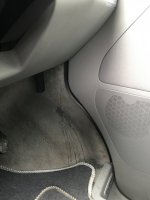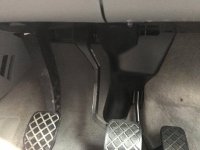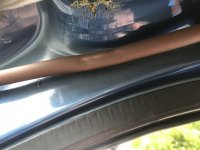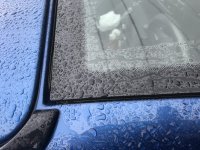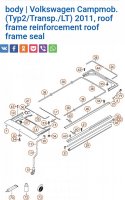Hi Ian,
The roof channels have fixings in them, there are others posts where people have had leaks from faulty roof rail, but that showed more of a general wetting in the pop top, not a specific area like your issue.
In your earlier post you mentioned that you could see water tracking down the windscreen edge. Was the water from the roof during rain or did you apply the water to test the area for leaks ?
windscreen replacement has not fixed the problem, but should now discount that potential issue. Did you ask the fitter to look for possible water entry points or observations whilst the windscreen was out ?
Following a logical path you now need to investigate other possible options and discount the various possibilities.
You sound confident that the problem is not around the internal drain pipe or seal, but I would revisit this potential issue to discount this fully
1j With the A pillar trim panel removed, repeat the drain test , to determine if the pipe Is split to discount this fully and unequivocally. Use the syringe method making sure water is only discharged down the pipe ( not around the general roof area)
Repeat this test several times (important) checking each time for water ingress and allowing enough time between test for the water to naturally work its way through to the foot well.
Before each test check and Dry the whole area and route of the water from the roof downwards ( inside and out side the vehicle, where you can see it)
place some paper towel in the area where water was observed in the cab previously ( this will assist visually)
After the syringe test and if this proves uneventful,
2) With the roof and bonnet up: pour a measured amount of water into the the general area of the roof problem, ( flood the area ) place a bowl or other receptical under the exit point, to collect the water, is the water a similar amount to the “ measured amount” poured in the area of the suspected problem ?
(Do this with the bonnet up)
Look for signs of water running down the drain pipe over it’s visible length (as observed previously)
Look at the path of the water and where it flows and how it dissipates
( video it if necessary to help you review later)
If the amount of water collected under the van is similar to the measured amount discharged and there are no obvious signs of water tracking down the drain pipe ( or signs of water inside the vehicle footwell) this discounts the seal around the pipe and the pipe itself for the section from the top seal to where you can no longer see the pipe.
water observed running down the pipe where you can see the pipe indicates the seal or a split pipe.
If water ingress is observed in the footwell, but is not observed from the area where trim is removed, it could be the pipe is split where you cannot see the pipe or elsewhere in the engine Bay Area?
Is the amount of water discharged, similar to the amount collected ? (Was the amount observed inside the vehicle ( if any) commensurate with the amount not collected under the van ?
During the water test inspect under the bonnet and Check the scuttle panel and area in the engine bay looking for points where water could enter the cab ( follow and investigate any water tracking from the test in to each area).
3) With the roof and bonnet down, get an assistant to flood the roof area,, simulating a deluge, whilst you sit in the van and look for water ingress.
Unfortunately water ingress is very hard to pin point unless you can physically see the specific area where it is coming in, it will be a case of trial and error and discounting the possible options.
Good luck, I don’t envy your situation, Report back on any findings or not as the case may be.
